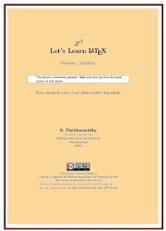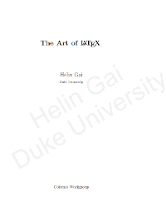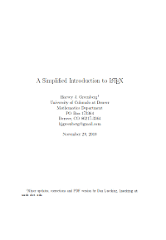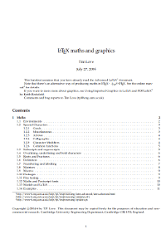Last Updated on August 17, 2024
5. Let’s Learn LaTeX by S. Parthasarathy

Let’s Learn LaTeX recommends hacking as a good method of learning LaTeX.
It gives 30 ‘lessons’ which show various aspects of LaTeX.
This book is not intended to address all aspects of LaTeX, but as a DIY approach to learn the system.
The book is written by a teacher and mature user of LaTeX.
The contents of the book:
- Learning by doing.
- Basics.
- Bibliographies in LaTeX.
- Tables.
- Languages.
- Templates.
- For maths lowers.
- Misc tools.
- The big picture.
This book is distributed under the Creative Commons Attribution-Sharelike 4.0 Unported license.
6. The Art of LaTeX by Helin Gai

The book covers the following topics:
- The Grand History of TeX – a general overview of the history of TeX/LaTeX.
- LaTeX Singing on Your Computer – set up LaTeX on Windows, Mac OS X, and Linux.
- Getting Started.
- Playing with Text – focuses on how you enter text and set type. Topics covered include: how to enter the characters not readily available on your keyboard, how to change the typeface of your text, etc.
- Working with Paragraphs – helps you deal with paragraphs, starting with basic controls over line breaks, moving on to the details of TeX’s typesetting engine.
- Elements of Your Document – cross references, listing items, columns, notes, programming codes, making boxes, index.
- LaTeX with Designers – focuses on how to design with LaTeX.
- When TeX Dates Math – goes into detail about how to typeset math properly.
- Tables and Graphics.
The book is released under an open source license, the Creative Commons Attribution-ShareAlike license.
7. A Simplified Introduction to LaTeX by Harvey J. Greenberg

A Simplified Introduction to LaTeX is billed as an accessible introduction for the beginner.
It’s a quick entry to LaTeX designed for students in an undergraduate seminar.
LaTeX maths and graphics is a short handout that helps the reader start to get to grips with LaTeX.
The book is 147 pages.
The maths’ section of the book covers:
- Environments.
- Special Characters – Greek, arrows, calligraphic, and more.
- Subscripts and superscripts.
- Overlining, underlining and bold characters.
- Roots and fractions.
- Delimiters.
- Numbering and labelling.
- Matrices.
- Macros.
- Packages.
- Fine tuning.
- Maths and Postscript fonts.
- Matlab and LaTeX.
- Examples.
The book’s second chapter examines Postscript, scaling, rotation, clipping, wrap-around and shadows. GIF, jpeg files, and PStricks are mentioned.
It’s permitted to copy this document for the purposes of education and non-commercial research.
8. LaTeX maths and graphics by T. P. love

LaTeX maths and graphics is a short handout that helps the reader start to get to grips with LaTeX.
The maths’ section of the book covers:
- Environments.
- Special Characters – Greek, arrows, calligraphic, and more.
- Subscripts and superscripts.
- Overlining, underlining and bold characters.
- Roots and fractions.
- Delimiters.
- Numbering and labelling.
- Matrices.
- Macros.
- Packages.
- Fine tuning.
- Maths and Postscript fonts.
- Matlab and LaTeX.
- Examples.
The book’s second chapter examines Postscript, scaling, rotation, clipping, wrap-around and shadows. GIF, jpeg files, and PStricks are mentioned.
It’s permitted to copy this document for the purposes of education and non-commercial research.
Next page: Page 3 – Using LaTeX to Write a PhD Thesis and more books
Pages in this article:
Page 1 – LaTeX Tutorials: A Primer and more books
Page 2 – Let’s Learn LaTeX and more books
Page 3 – Using LaTeX to Write a PhD Thesis and more books
Page 4 – The Computer Science of TeX and LaTeX and more books
All books in this series:
| Free Programming Books | |
|---|---|
| Ada | ALGOL-like programming language, extended from Pascal and other languages |
| Agda | Dependently typed functional language based on intuitionistic Type Theory |
| Arduino | Inexpensive, flexible, open source microcontroller platform |
| Assembly | As close to writing machine code without writing in pure hexadecimal |
| Awk | Versatile language designed for pattern scanning and processing language |
| Bash | Shell and command language; popular both as a shell and a scripting language |
| BASIC | Beginner’s All-purpose Symbolic Instruction Code |
| C | General-purpose, procedural, portable, high-level language |
| C++ | General-purpose, portable, free-form, multi-paradigm language |
| C# | Combines the power and flexibility of C++ with the simplicity of Visual Basic |
| Clojure | Dialect of the Lisp programming language |
| ClojureScript | Compiler for Clojure that targets JavaScript |
| COBOL | Common Business-Oriented Language |
| CoffeeScript | Transcompiles into JavaScript inspired by Ruby, Python and Haskell |
| Coq | Dependently typed language similar to Agda, Idris, F* and others |
| Crystal | General-purpose, concurrent, multi-paradigm, object-oriented language |
| CSS | CSS (Cascading Style Sheets) specifies a web page’s appearance |
| D | General-purpose systems programming language with a C-like syntax |
| Dart | Client-optimized language for fast apps on multiple platforms |
| Dylan | Multi-paradigm language supporting functional and object-oriented coding |
| ECMAScript | Best known as the language embedded in web browsers |
| Eiffel | Object-oriented language designed by Bertrand Meyer |
| Elixir | Relatively new functional language running on the Erlang virtual machine |
| Erlang | General-purpose, concurrent, declarative, functional language |
| F# | Uses functional, imperative, and object-oriented programming methods |
| Factor | Dynamic stack-based programming language |
| Forth | Imperative stack-based programming language |
| Fortran | The first high-level language, using the first compiler |
| Go | Compiled, statically typed programming language |
| Groovy | Powerful, optionally typed and dynamic language |
| Haskell | Standardized, general-purpose, polymorphically, statically typed language |
| HTML | HyperText Markup Language |
| Icon | Wide variety of features for processing and presenting symbolic data |
| J | Array programming language based primarily on APL |
| Java | General-purpose, concurrent, class-based, object-oriented, high-level language |
| JavaScript | Interpreted, prototype-based, scripting language |
| Julia | High-level, high-performance language for technical computing |
| Kotlin | More modern version of Java |
| LabVIEW | Designed to enable domain experts to build power systems quickly |
| LaTeX | Professional document preparation system and document markup language |
| Lisp | Unique features - excellent to study programming constructs |
| Logo | Dialect of Lisp that features interactivity, modularity, extensibility |
| Lua | Designed as an embeddable scripting language |
| Markdown | Plain text formatting syntax designed to be easy-to-read and easy-to-write |
| Objective-C | Object-oriented language that adds Smalltalk-style messaging to C |
| OCaml | The main implementation of the Caml language |
| Pascal | Imperative and procedural language designed in the late 1960s |
| Perl | High-level, general-purpose, interpreted, scripting, dynamic language |
| PHP | PHP has been at the helm of the web for many years |
| PostScript | Interpreted, stack-based and Turing complete language |
| Prolog | A general purpose, declarative, logic programming language |
| PureScript | Small strongly, statically typed language compiling to JavaScript |
| Python | General-purpose, structured, powerful language |
| QML | Hierarchical declarative language for user interface layout - JSON-like syntax |
| R | De facto standard among statisticians and data analysts |
| Racket | General-purpose, object-oriented, multi-paradigm, functional language |
| Raku | Member of the Perl family of programming languages |
| Ruby | General purpose, scripting, structured, flexible, fully object-oriented language |
| Rust | Ideal for systems, embedded, and other performance critical code |
| Scala | Modern, object-functional, multi-paradigm, Java-based language |
| Scheme | A general-purpose, functional language descended from Lisp and Algol |
| Scratch | Visual programming language designed for 8-16 year-old children |
| SQL | Access and manipulate data held in a relational database management system |
| Standard ML | General-purpose functional language characterized as "Lisp with types" |
| Swift | Powerful and intuitive general-purpose programming language |
| Tcl | Dynamic language based on concepts of Lisp, C, and Unix shells |
| TeX | Markup and programming language - create professional quality typeset text |
| TypeScript | Strict syntactical superset of JavaScript adding optional static typing |
| Vala | Object-oriented language, syntactically similar to C# |
| VHDL | Hardware description language used in electronic design automation |
| VimL | Powerful scripting language of the Vim editor |
| XML | Rules for defining semantic tags describing structure ad meaning |
